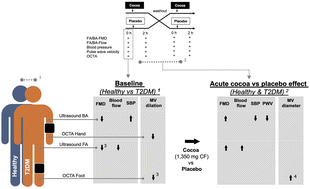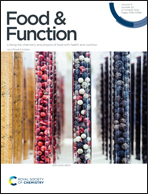Cocoa flavanol consumption improves lower extremity endothelial function in healthy individuals and people with type 2 diabetes
Abstract
Background: diabetes and age are major risk factors for the development of lower extremity peripheral artery disease (PAD). Cocoa flavanol (CF) consumption is associated with lower risk for PAD and improves brachial artery (BA) endothelial function. Objectives: to assess if femoral artery (FA) endothelial function and dermal microcirculation are impaired in individuals with type 2 diabetes mellitus (T2DM) and evaluate the acute effect of CF consumption on FA endothelial function. Methods: in a randomised, controlled, double-blind, cross-over study, 22 individuals (n = 11 healthy, n = 11 T2DM) without cardiovascular disease were recruited. Participants received either 1350 mg CF or placebo capsules on 2 separate days in random order. Endothelial function was measured as flow-mediated dilation (FMD) using ultrasound of the common FA and the BA before and 2 hours after interventions. The cutaneous microvasculature was assessed using optical coherence tomography angiography. Results: baseline FA-FMD and BA-FMD were significantly lower in T2DM (FA: 3.2 ± 1.1% [SD], BA: 4.8 ± 0.8%) compared to healthy (FA: 5.5 ± 0.7%, BA: 6.0 ± 0.8%); each p < 0.001. Whereas in healthy individuals FA-FMD did not significantly differ from BA-FMD (p = 0.144), FA-FMD was significantly lower than BA-FMD in T2DM (p = 0.003) indicating pronounced and additional endothelial dysfunction of lower limb arteries (FA-FMD/BA-FMD: 94 ± 14% [healthy] vs. 68 ± 22% [T2DM], p = 0.007). The baseline FA blood flow rate (0.42 ± 0.23 vs. 0.73 ± 0.35 l min−1, p = 0.037) and microvascular dilation in response to occlusion in hands and feet were significantly lower in T2DM subjects than in healthy ones. CF increased both FA- and BA-FMD at 2 hours, compared to placebo, in both healthy and T2DM subgroups (FA-FMD effect: 2.9 ± 1.4%, BA-FMD effect 3.0 ± 3.5%, each pintervention< 0.001). In parallel, baseline FA blood flow and microvascular diameter significantly increased in feet (3.5 ± 3.5 μm, pintervention< 0.001) but not hands. Systolic blood pressure and pulse wave velocity significantly decreased after CF in both subgroups (−7.2 ± 9.6 mmHg, pintervention = 0.004; −1.3 ± 1.3 m s−1, pintervention = 0.002). Conclusions: individuals with T2DM exhibit decreased endothelial function that is more pronounced in the femoral than in the brachial artery. CFs increase endothelial function not only in the BA but also the FA both in healthy individuals and in those with T2DM who are at increased risk of developing lower extremity PAD and foot ulcers.

- This article is part of the themed collection: International Conference on Polyphenols and Health (ICPH2022) special collection


 Please wait while we load your content...
Please wait while we load your content...